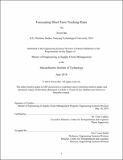| dc.contributor.advisor | Chris Caplice. | en_US |
| dc.contributor.author | Bai, Xiwen | en_US |
| dc.contributor.other | Massachusetts Institute of Technology. Supply Chain Management Program. | en_US |
| dc.date.accessioned | 2018-09-17T14:50:00Z | |
| dc.date.available | 2018-09-17T14:50:00Z | |
| dc.date.copyright | 2018 | en_US |
| dc.date.issued | 2018 | en_US |
| dc.identifier.uri | http://hdl.handle.net/1721.1/117796 | |
| dc.description | Thesis: M. Eng. in Supply Chain Management, Massachusetts Institute of Technology, Supply Chain Management Program, 2018. | en_US |
| dc.description | This electronic version was submitted by the student author. The certified thesis is available in the Institute Archives and Special Collections. | en_US |
| dc.description | Cataloged student-submitted from PDF version of thesis. | en_US |
| dc.description | Includes bibliographical references (pages 79-83). | en_US |
| dc.description.abstract | Transportation costs constitute an important part of total logistics costs and have a dramatic impact on all kinds of decisions across the supply chain. Accurate estimation of transportation costs can help shippers make better decisions when planning transportation budgets and can help carriers estimate future cash flows. This study develops a forecasting model that predicts both contract and spot rates for truckload transportation on individual lanes for the next seven days. This study considers several input variables, including lagged values of spot and contract rates, rates on adjacent routes and volumes. The architectural approach to short-term forecasting is a neural network based on Nonlinear Autoregressive Models with eXogenous input (NARX) models. NARX models are powerful when modelling complex, nonlinear and dynamic systems, especially time series. Traditional time series models, including autoregressive integrated moving average (ARIMA), are also used and results from different models are compared. Results show that the NAR model provides better short-term forecasting performance for spot rates than the ARIMA model, while the ARIMA model performs slightly better for contract rates. However, for a longer-term forecast, the NARX model provides better results for contract rates. The results from this study can be applied to industrial players for their own transportation rate forecasting. These results provide guidelines for both shippers and carriers regarding what model to use, when to update the model with new information, and what forecasting error can be normally expected from the model. | en_US |
| dc.description.statementofresponsibility | by Xiwen Bai. | en_US |
| dc.format.extent | 84 pages | en_US |
| dc.language.iso | eng | en_US |
| dc.publisher | Massachusetts Institute of Technology | en_US |
| dc.rights | MIT theses may be protected by copyright. Please reuse MIT thesis content according to the MIT Libraries Permissions Policy, which is available through the URL provided. | en_US |
| dc.rights.uri | http://dspace.mit.edu/handle/1721.1/7582 | en_US |
| dc.subject | Supply Chain Management Program. | en_US |
| dc.title | Forecasting short term trucking rates | en_US |
| dc.type | Thesis | en_US |
| dc.description.degree | M. Eng. in Supply Chain Management | en_US |
| dc.contributor.department | Massachusetts Institute of Technology. Supply Chain Management Program | |
| dc.identifier.oclc | 1051222963 | en_US |
